

 The South African
The South African
by S A Watt
After the events of 'Black Week', during which the British Army suffered reverses at Stormberg (10 December 1899), Magersfontein (11 December 1899) and Colenso (15 December 1899), the British War Office, in response to a request for reinforcements, called for volunteers from different regiments for active service in South Africa. In addition, the formation of a corps of mounted men, drawn from the regiments of Yeomanry, termed Imperial Yeomanry, was called to assist. Candidates for enlistment had to be between the ages of 20 and 35 and had to satisfy the authorities that they were good riders and marksmen.
At such a time when thousands of men left Britain to serve in South Africa, it was felt that women too should assist in the war effort. Lady Chesham and Lady Georgiana Curzon (who later became Countess Howe) felt so strongly the need to mitigate the horrors of war that they resolved to organise a hospital for the Imperial Yeomanry in South Africa. A letter published in London newspapers, followed later by another, appealed to the British nation to come forward with funds. The response was termed enthusiastic in that an amount of some £174 000 was eventually collected; sufficient to equip and remunerate the personnel for four hospitals (initially only one was envisaged), a convalescent home, a field hospital and a bearer company. An Imperial Yeomanry Hospital Committee, under the chairmanship of the above-named ladies, was soon established, and began to function in early January 1900. The War Office and the Red Cross sanctioned the scheme, with the proviso that the hospital should not be kept exclusively for the Yeomanry. This was agreed to by the Committee. During the remainder of the month the medical personnel were appointed, and between 10 and 17 February 1900 the entire staff with the exception of nurses, departed for South Africa.
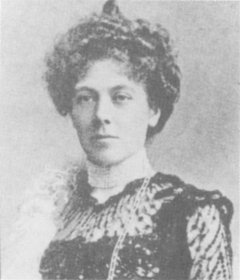
Georgiana Curzon
(later Countess Howe)
was chairman of the Imperial
Yeomanry Hospitals Fund
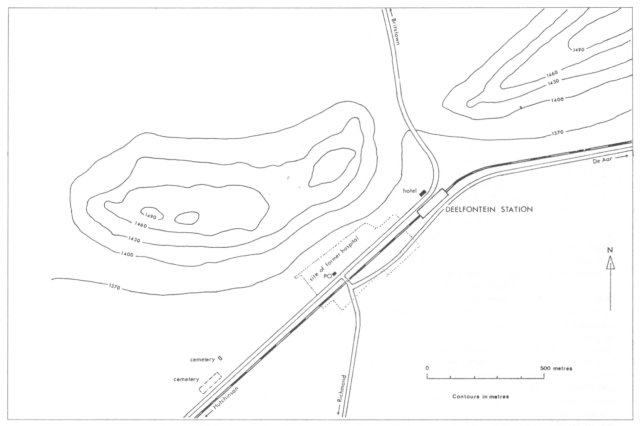
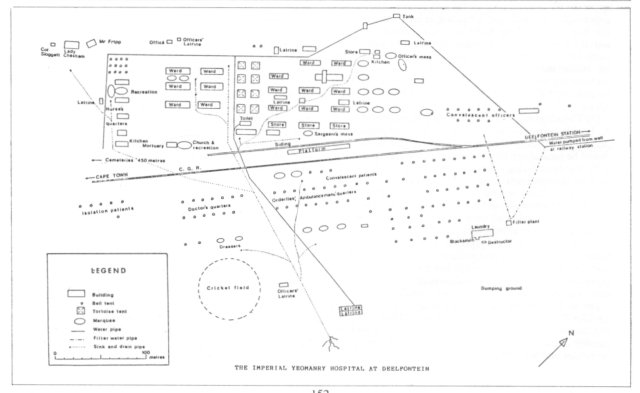
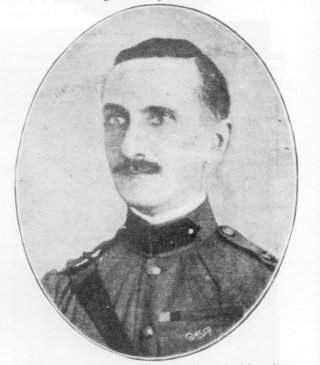

Mr Alfred Fripp, who was the
Senior Surgeon at Deelfontein,
eventually returned to Britain
during April 1901.
Prior to its opening, the military authorities completed a railway siding
in front of the hospital in order to facilitate the removal of patients
brought by rail. Water had been laid on by means of piping it from a tank
at the foot of the hill behind. Flowing under the force of gravity it
was easily distributed throughout the camp. Pathways, lined with stones
painted white, gave the camp the appearance of a small town.
On 19 March the first ambulance train with 101 ill and wounded men arrived
at Deelfontein and at the end of the month some 300 had been accommodated.
By then prefabricated buildings had been erected, a few big marquees and
tortoise tents pitched and a water drainage system established. To keep
outbreaks of diseases to a minimum, certain standards of cleanliness were
adhered to. No human excreta was carried by drains, all of it being removed
by buckets and buried away from the camp. Numerous sinks were placed all
over the hospital complex; utensils infected with enteric (today called
typhoid) fever were disinfected, and all mattresses used by enteric patients
were disinfected and washed.
In mid-May Lady Chesham and her daughter arrived. The distribution by these two women of newspapers and books as well as luxury items, including tobacco, was greatly appreciated by the patients.
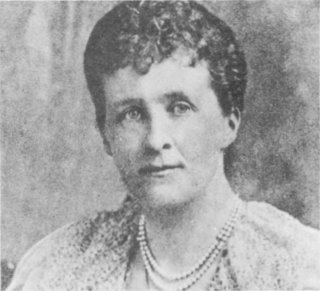
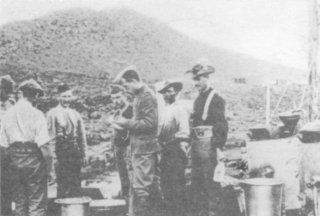
The dairy was situated near the
northern extremity of the hospital complex.
It was constructed of iron and wood and
'two sterilisers were erected
close to the door'.
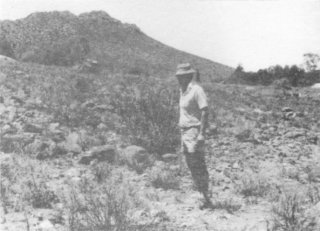
The author stands on the same spot
some 86 years later where some of
the 'milkmen' queued to collect milk.
Recreation was provided for the patients as well as for the hospital staff. For the not-so-ill an occasional concert provided both entertainment and relaxation. For the healthy and energetic, football and cricket were played on the flat ground across the railway to the east of the hospital.
With the acquisition of additional funds, the Yeomanry Committee decided to enlarge the hospital at Deelfontein, the size of which has already been alluded to. In addition, a demand for medical assistance in Cape Town, led to the establishment of a Yeomanry Depot. Consequently, a small hospital, of 100 beds, was started at Mackenzie's Farm at Maitland. This was followed by a Yeomanry Field Hospital and Bearer Company which accompanied various columns. As a result of privations in the field, most of the personnel of the Bearer Company became ill or suffered from fatigue, and accordingly it had ceased to exist by April 1901. With the fall of Pretoria (5 June 1900) to Lord Roberts' forces, which included a considerable number of Imperial Yeomanry, the Committee decided to establish an additional base hospital in that city. The Yeomanry Hospital opened in August 1900, and ceased to be under the control of the Yeomanry authorities from October 1901 when it became the No.22 General Hospital. The hospital at Mackenzie's Farm continued to be used until April 1901 when it passed into the control of the Cape Government who used it as a plague hospital. A convalescent home for Yeomanry offices was established in Johannesburg in March 1901 and remained open until October of that year when use of the building reverted to its owner. A new hospital was opened at Elandsfontein, near Germiston, in June 1901. It eventually contained 138 beds and was transferred to the management of the Army Medical Authorities in December 1901.
As a result of the high number of cases of dysentery and enteric faver reported amongst the soldiers of Lord Roberts' Army while in Bloemfontein, a Royal Commission was appointed to investigate the care and treatment of those who had contracted illness or had been wounded during the war. The Commission of six members, under its President, Lord Justice Romer, proceded to South Africa, and took evidence at many of the hospitals located on the lines of communication. The Commission visited Deelfontein on 30 August 1900 and were impressed with the doctors and patients they interviewed.
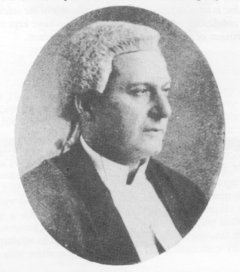
A six-man Commission under the
chairmanship of Lord Justice Romer,
appointed to investigate the care
of the wounded and ill in South Africa,
visited Deelfontein on 30 August 1900.
The commission expressed approval of whom
they interviewed and what they saw.
In early December 1900 the Cape Colony was invaded by the Boers, and during
the next three months Deelfontein hospital became the centre of hostililites.
Many sick and wounded (including a large number of surgical cases) were
received from the columns operating in the surrounding district.
On termination of the Committee's contracts with the hospital staff, negotiations
for the transfer of the entire hospital were entered into with the military
authorities. The transfer took place on 1 April 1901 (a little more than
a year after the date of opening) with most of the staff returning to Britain.
By that time 6 093 patients had been admitted to Deelfontein hospital of
whom 81 (including 18 from the Imperial Yeomanry regiments or hospital
staff) had been buried in the cemetery. The hospital then became known
as No.21 General Hospital with Colonel Sloggett remaining in charge.
The frequency of burials at Deelfontein declined during the latter stages
of the war. Before the termination of hostilities (31 May 1902) a small
cemetery containing five graves was established, while nearby another cemetery
containing many more graves was enclosed by a large rectangular-shaped
stone wall. The approach to the large cemetery was then lined by trees,
while the graves within this cemetery were identified by marble crosses
or with boards bearing the soldiers' particulars. A monument consisting
of a marble cross on a large cairn was erected within the cemetery. On
the cross appeared the names of those men who had died in the service of
the Imperial Yeomanry Hospital.
Deelfontein today consists of a few buildings clustered around the railway
station and several more are scattered over the Karoo plain. A visitor
cannot help but notice the large IYH lettering, measuring 25 metres in
length, etched on the hill side. Faintly discernable beneath is the word
DEELFONTEIN. Of the Yeomanry Hospital complex, no buildings or stone-lined
pathways are to be seen, and the only evidence that structures once stood
there, are stone embankments, depressions and dilapidated mortar floors.
Some distance away from the site are depressions in the ground where holes
once existed in which the excreta of typhoid patients was buried.
Deelfontein station in 1900 was described as being '...a large water tank
and pumping plant, pumpman's cottage ... and a small store.' Water, then
drawn from a well to the south of the station, is now pumped from a borehole
located to the north-east of the station. Several buildings have been erected
in the intervening 86 years. A hotel consisting of a corrugated iron structure,
in front of which stands an archway with the word 'Yeomanry', was probably
one of the first buildings to be built. Subsequent additions were made
comprising more sturdy buildings which, until recently, were used for
accommodation. Other buildings adjoining the hotel included a liquor section
(opened in 1935) and a general store (opened in 1938). The sole white inhabitant
in the hotel (and for that matter of Deelfontein), a Mr J Adamstein, who
resided there for many years, has now left the place.
Between the station and the cemeteries the observer sees several other
buildings and these include a school for coloured pupils, a post office
(now disused) and a compound which provides accommodation for railway workers.
Some 450 metres away in a south-westerly direction from where the hospital buildings stood are two cemeteries containing the graves of 132 soldiers and civilians. A graveyard with 5 graves contains the earliest burials performed at Deelfontein. Perhaps the ground was too hard (many stones are seen in the vicinity) and this persuaded the hospital authorities to select a site for another cemetery some 60 metres away. In the latter, 128 men are buried. A big stone wall, which enclosed the 'large' cemetery has now disappeared. A reservoir nearby has a stone wall (possibly the stones which once comprised the walls of the cemetery). Prior to the cessation of hostilities (31 May 1902) the original rectangular enclosure was filled with additional graves. After the war, additional burials, including reinterments, resulted in the creation of a single line of 21 graves projecting beyond the original enclosure. Most of the graves in the two cemeteries are identified by a metal cross to which is attached a metal disc bearing the particulars of the soldier. The remainder are marked by marble crosses. In the large cemetery, two adjacent graves, identified by different markers, denote the same person - an obvious error made by either the graves commission (whose work included the manufacture of the metal crosses) or a family member (who was responsible for the marble cross).
Dominating the scene is the large monument on which are inscribed the names of 8 men of the Yeomanry Hospital Staff, 6 of whom died of disease and are buried at Deelfontein. Another man was killed accidentally and he was buried at Worcester but reinterred at Maitland, Cape Town.
Today the responsibility for the care of the cemeteries has been undertaken by an enthusiastic De Aar resident, Mr Clarence Wood. The clearing of weeds and shrubs within the cemeteries, the painting of the crosses and stones over each grave and the possibility of applying a coat of paint to the IYH lettering on the hillside forms part of a continuous project undertaken by a small but interested group of members belonging to the De Aar Rotary Club.
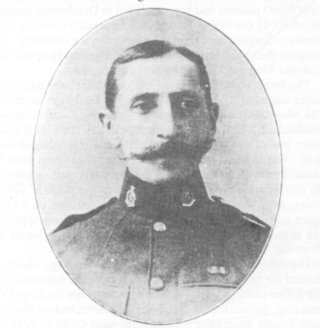
Major Thomas Alfred Perry Marsh
of the Royal Army Medical Corps,
died of enteric (today called typhoid)
fever on 22 May 1900.
He was born in February 1856, entered the army in July 1882, being promoted
to the rank of major in the RAMC in 1894. Major Marsh served in Burma
during 1885-87 where he was in charge of the medical personnel
attached to a mountain battery. He arrived in South Africa during
November 1899 and contracted enteric fever whilst in charge of the
military hospital at De Aar. He died at Deelfontein and his grave is
identified by a marble cross and kerb. He is also remembered in De Aar
where an obelisk, standing in the military precint of the town's cemetery,
commemorates the men who died while serving with the Third Stationary Hospital.
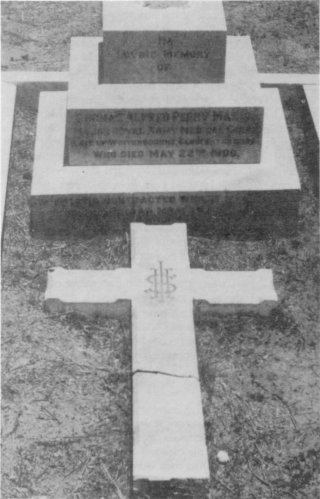
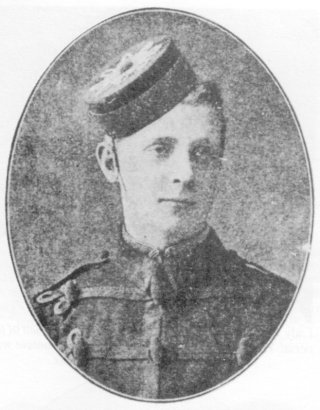
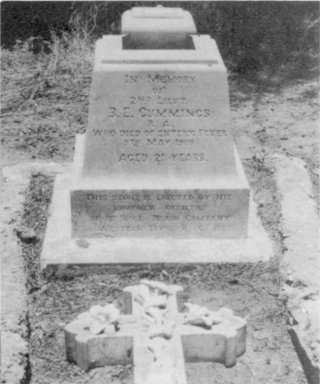
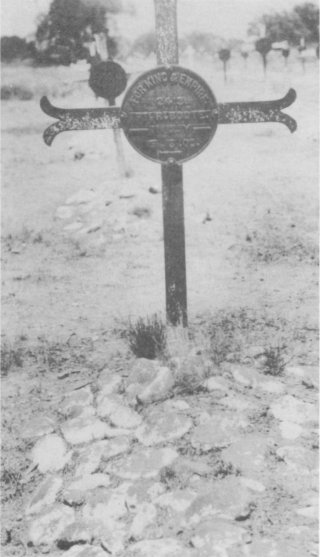
Most of the graves are identified by a metal cross
on which a metal disc is attached
describing the particulars of the soldier.
The dry conditions which prevail in the Karoo
have kept corrosion of the grave markers to a minimum
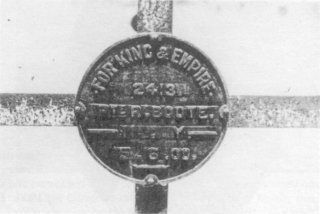
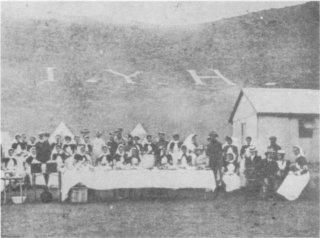
A tea party was held in honour of
Queen Victoria's birthday on 24 May 1900.
At the tea table, placed between the tortoise
tents and one of the wards, sat most of the nurses.
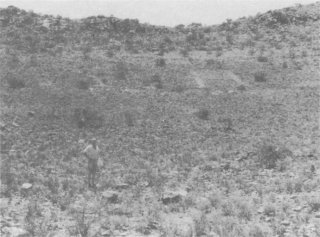
A visit to the same spot in December 1986
revealed no trace of where the ward stood.
The letter IYH (Imperial Yeomanry Hospital)
is faintly discernible behind. Later the word
DEELFONTEIN was added.
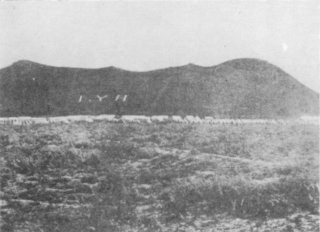
The hospital encampment was established
at the foot of the range of hills,
the highest point which, at Deelfontein
stands 150 metres above the plain.
The letters IYH are 25 metres long.
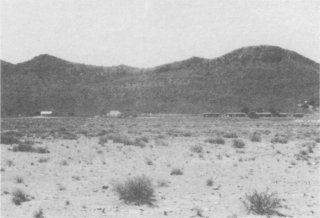
None of the buildings which constitute
the hospital is seen today.
The building seen with the shiny roof
is the Deelfontein Post Office
(now disused), while the compound,
seen on the left, provides accommodation
for railway workers.
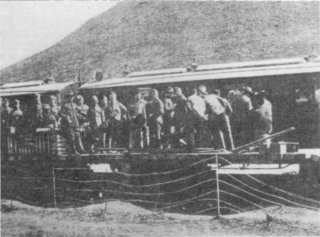
Prior to the opening of the hospital
a temporary railway siding was contructed
facilitating the transport of the patients
direct from the train to the ward.
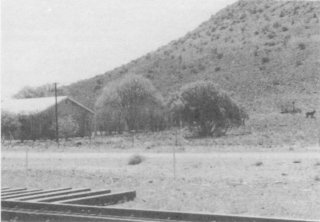
The trackbed of the present-day
railway is constructed on the old
Cape Government Railway. The
building nearby used to be the
Deelfontein Post Office.
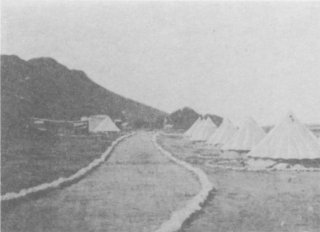
A view towards Deelfontein railway station
with tents used for convalescent officers.
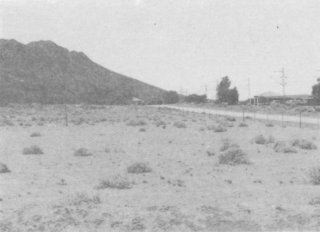
There is no evidence today
to suggest that stone pathways or
circular constructions around
the tents once existed. In the
distance is Deelfontein station
next to which several buildings
have been erected since 1900.
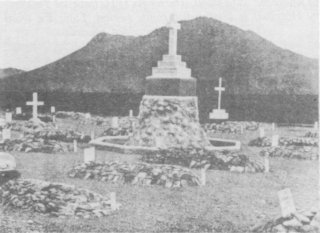
All the dead who were buried
at Deelfontein, were laid to rest
in two cemeteries, one of which has
5 graves while the other contains 129,
a view of which is shown above. A
large stone wall surrounded the graves,
and a monument to the memory of
the Imperial Yeomanry Hospital staff
dominates the enclosure.
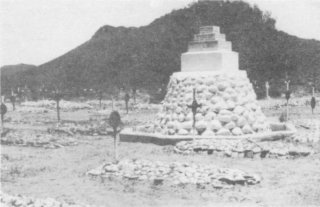
A visit to the large cemetery
in December 1986 revealed that
the stone wall had disappeared
(probably the wall of a nearby
reservoir was constructed from
the stones taken from the cemetery).
All the temporary markers identifying
the graves have been replaced by
metal crosses, to each of which
a disc has been attached.
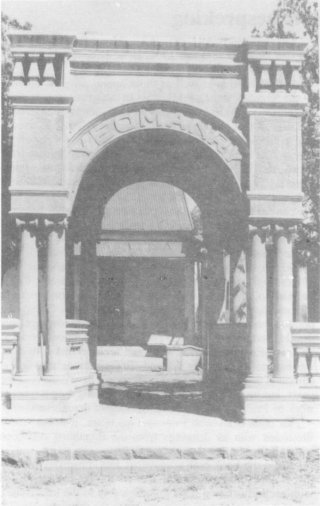
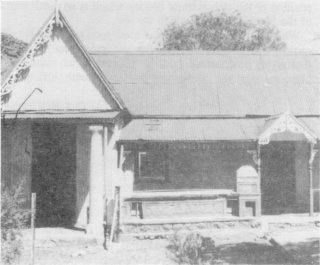
The Hotel Yeomanry, built after the Anglo-Boer War, stands near
the railway station. Later other buildings were erected next to
the hotel in the 1920s. These included a bottle store (opened
in 1935) and a general store (opened in 1938). All
these
commercial enterprises
have now ceased functioning.
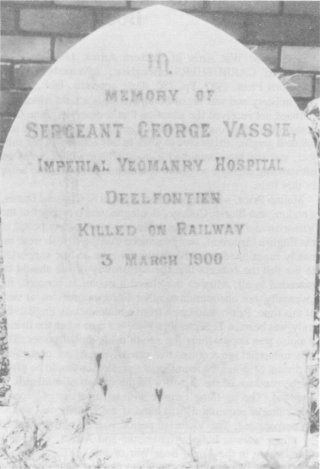
Credits
Adamstein, J. formerly resident at Deelfontein.
Amery, L (General editor), The Times History of the War in South Africa
Vol.6. London 1909.
Appendix to the Minutes of Evidence taken Before the Royal Commission
appointed to consider and report upon the Care and Treatment of the Sick
and Wounded during the South African Campaign 1901 (Cd 453,454) London.
Barbour, Miss F, of the McGregor Museum, Kimberley.
Dooner, Mildred, G : The Last Post London 1903 (Reprint 1980)
Good Hope Society (Report of the) for the Sick and Wounded in War: South
African War 1899 - 1902. Cape Town 1902.
Government Printer - 1:50 000 topographical map. Pretoria
Gough-Palmer, M, Secretary of the British War Graves Committee of the National
Monuments' Council, Pretoria
Graphic (The) Magazines : January 1900 - July 1900. London 1900.
Howe (Countess). The Imperial Yeomanry Hospitals in South Africa 1900
- 1902. Vols 1 and 2. London 1902.
Illustrated London News (The) Magazines : January 1900 - December
1900. London 1900.
Military History Journals : June 1976; December 1976 - Johannesburg
1976.
South African War Casualty Roll (The). London 1982.
Wood C, resident of De Aar.
Return to Journal Index OR Society's Home page
South African Military History Society / scribe@samilitaryhistory.org